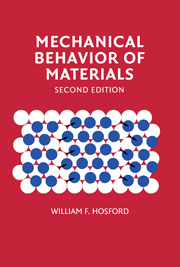Book contents
- Frontmatter
- Contents
- Preface
- 1 Stress and Strain
- 2 Elasticity
- 3 Mechanical Testing
- 4 Strain Hardening of Metals
- 5 Plasticity Theory
- 6 Strain Rate and Temperature Dependence of Flow Stress
- 7 Slip and Crystallographic Textures
- 8 Dislocation Geometry and Energy
- 9 Dislocation Mechanics
- 10 Mechanical Twinning and Martenitic Shear
- 11 Hardening Mechanisms in Metals
- 12 Discontinuous and Inhomogeneous Deformation
- 13 Ductility and Fracture
- 14 Fracture Mechanics
- 15 Viscoelasticity
- 16 Creep and Stress Rupture
- 17 Fatigue
- 18 Residual Stresses
- 19 Ceramics and Glasses
- 20 Polymers
- 21 Composites
- 22 Mechanical Working
- APPENDIX I Miller Indices
- APPENDIX II Stereographic Representation of Orientations
- Index
8 - Dislocation Geometry and Energy
Published online by Cambridge University Press: 05 June 2012
- Frontmatter
- Contents
- Preface
- 1 Stress and Strain
- 2 Elasticity
- 3 Mechanical Testing
- 4 Strain Hardening of Metals
- 5 Plasticity Theory
- 6 Strain Rate and Temperature Dependence of Flow Stress
- 7 Slip and Crystallographic Textures
- 8 Dislocation Geometry and Energy
- 9 Dislocation Mechanics
- 10 Mechanical Twinning and Martenitic Shear
- 11 Hardening Mechanisms in Metals
- 12 Discontinuous and Inhomogeneous Deformation
- 13 Ductility and Fracture
- 14 Fracture Mechanics
- 15 Viscoelasticity
- 16 Creep and Stress Rupture
- 17 Fatigue
- 18 Residual Stresses
- 19 Ceramics and Glasses
- 20 Polymers
- 21 Composites
- 22 Mechanical Working
- APPENDIX I Miller Indices
- APPENDIX II Stereographic Representation of Orientations
- Index
Summary
Introduction
It was well know in the late nineteenth century that crystals deformed by slip. In the early twentieth century, the stresses required to cause slip were measured by tension tests of single crystals. Dislocations were not considered until after it was realized that the measured stresses were far lower than those calculated from a simple model of slip. In the mid-1930s, G. I. Taylor, M. Polanyi, and E. Orowan independently postulated that preexisting crystal defects (dislocations) were responsible for the discrepancy between measured and calculated strengths. It took another two decades and the development of the electron microscope before dislocations were observed directly.
Slip occurs by the motion of dislocations. Many aspects of the plastic behavior of crystalline materials can be explained by dislocations. Among these are how crystals can undergo slip, why visible slip lines appear on the surfaces deformed crystals, why crystalline materials become harder after deformation, and how solute elements affect slip.
Theoretical Strength of Crystals
Once it was established that crystals deformed by slip on specific crystallographic systems, physicists tried to calculate the strength of crystals. However, the agreement between their calculated strengths and experimental measurements was poor. The predicted strengths were orders of magnitude too high, as indicated in Table 8.1.
- Type
- Chapter
- Information
- Mechanical Behavior of Materials , pp. 137 - 154Publisher: Cambridge University PressPrint publication year: 2009



